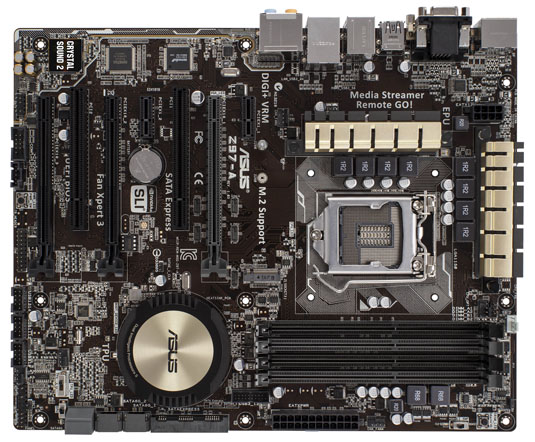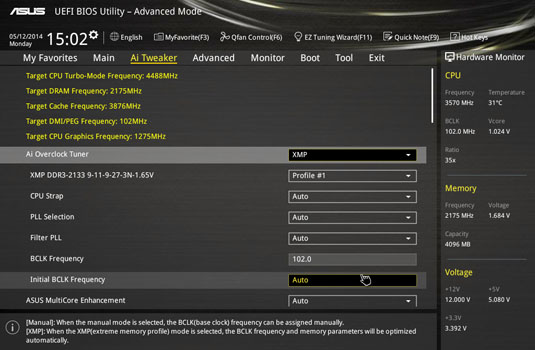Original URL: https://www.theregister.com/2014/05/27/review_asus_z97_a_intel_9_series_chipset/
Asus Z97-A puts Intel's 9 Series chipset through its paces
Revamped mobo finds its inner mojo
Posted in Personal Tech, 27th May 2014 09:04 GMT
Review Here we are again. Another Intel chipset series sees the light of day – but at least this time there isn’t a new socket to contend with... Well, at the very high end there is, but that’s for the X99 Express coming later.
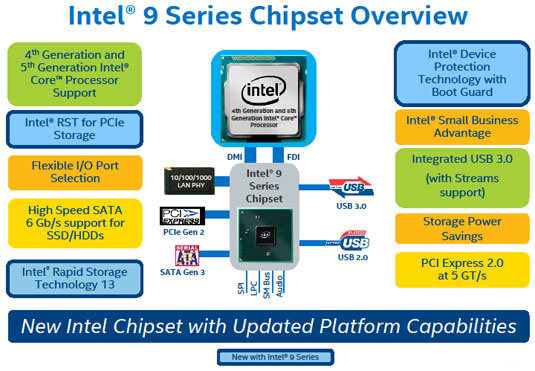
At launch there are two 9 series chipsets: the Z97 Express and the H97 Express. As with the previous 8 series chipsets, the new incarnations support the LGA1150 socketed CPUs.
The X99 Express, which is due some time in the second half of 2014, brings support for the upcoming 8-core Haswell-E CPU with the new LGA2011-3 socket and chipset supporting DDR4 memory, amongst other things.
So what’s new? To be honest not a lot – but what there is gives the platform a good degree of future proofing in both the storage and security areas. First up, and probably most importantly, the chipset supports M.2 and SATA Express formats using a PCI-E 2.0 x2 interface with the potential of up to 1GB/s bandwidth.
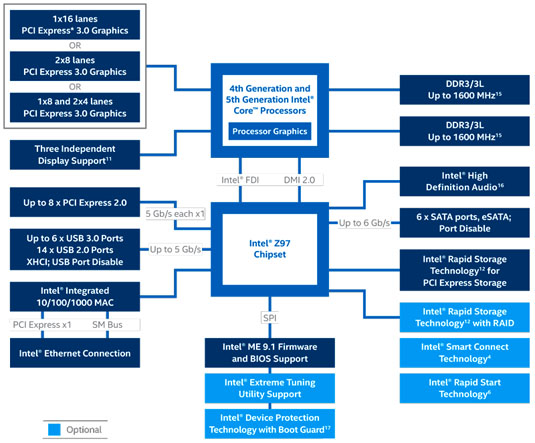
Intel 9 series chipset Z97 overview
Although the capability for much higher bandwidths with PCI-E-based drives exist, on the Z97 Intel has only released two of the PCI-E lanes for this purpose. The new chipset doesn’t offer any more lanes than the 24 featured on the previous Z87 chipset, and of these 24 lanes, 16 PCI-E 3.0 lanes are reserved for the graphics under the control of the CPU. Using just two lanes means you can either use M.2 or SATA Express, but not both at the same time.
To go with the new forms of storage available is the latest version of Intel’s Rapid Storage Technology. Version 13 of RST brings support for PCI-E-based drives, as well as SATA-based drives, enabling hybrid storage solutions using hard drives and an M.2 SSD.
There are security upgrades in the shape of Intel device protection and boot guard technology – two things normally associated with business platforms. The 9-series also accommodates the faster Devil Canyon versions of the Haswell range of CPUs, which should be coming soon.
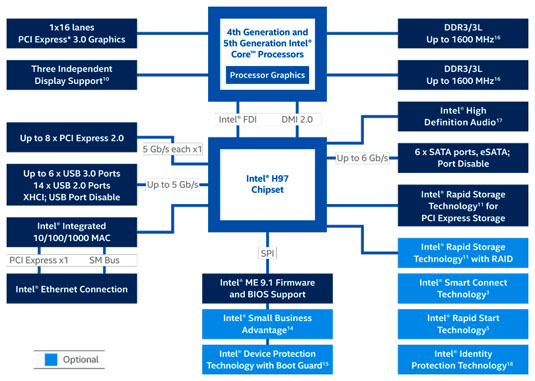
The H97 has some significant differences over the Z97 alternative
The Z97 supports overclocking and multi-graphics card setups using either one slot at x16 speed, two slots at x8/x8 or three slots at x8/x4/x4, so it should allow two card SLI or three card CrossFire setups. The H97 has no overclocking support and only provides for a single graphics card slot. The H97 also handles Intel’s Small Business Advantage platform.
The first motherboard I’ve got my mitts on which is built around the new chipset is from Asus in the shape of the Z97-A, the company’s entry level into the world of the Z97 and the successor to the popular Z87-A.
Pain-free overclocking
As it’s an Asus board it comes as no real surprise to find it crammed with features. On the Z97-A, the company has gone above and beyond what you’d normally find, especially for a board at this price point. It has a features list that wouldn’t have looked out of place on a fairly high-end offering a year ago.
If motherboard aesthetics are your thing, then the Z-97A may disappoint with its dark brown PCB with black and grey fittings and gold coloured heatsinks on the power components and the passive chipset cooler.
Space around the LGA1150 Socket may look a bit tight but I used a dual-fanned Noctua U9B SE2 for testing and it fitted without any problems… well, apart from the first memory slot being blocked by a fan, but that’s a given with third party coolers, in general. Still, you could always use low profile memory if you need all four slots filled.
Although the Noctua fitted without problems you may need to check clearances if you are using one of the very large coolers that are around these days.
Along with an M.2 socket 3 (for PCI-E type 2260/2280 M.2 drives), the Z-97A comes with SATA Express which uses Asus’s SRIS technology in the BIOS to maintain performance levels.
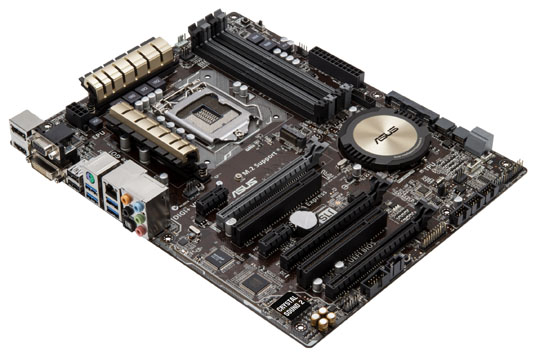
Not too cramped but be mindful that some components might encroach on other slots – click for a larger image
SRIS – or, to give it its full mouthful of a name, the Separate Reference Clock with Independent Spread Spectrum Clocking Architecture – has been developed along with Intel to ensure that timings between the SATA Express device and the motherboard are kept precisely in step with each other. This not only aids performance but also helps with any compatibility issues that might arise.
The ports for the SATA Express aren’t wasted if you don’t want to go down as the SATA-E route, as both of them can be used as standard SATA 6Gb/s ports giving the board a total of 6 SATA 6Gb/s interfaces. You must make sure that the SATA Express is turned off in the BIOS to allow this.
Ever since the graphical UEFI BIOS came about, Asus has been pretty much the master of it. With each update, it just gets better and better. For the Z97 there has been a complete refresh so the user interface is improved and offers more tweaking capabilities. It certainly makes the BIOS an even less daunting place to be in than in the old pre UEFI days.
Straight from the front EZ Mode page you can: alter memory profiles; boot priority; use the EZ system tuning; turn Intel’s RST on/off; check fan speeds (the fan icons are even animated); and manually adjust the CPU fan profile via Q-Fan tuning – all with a mouse click.
Whoosh! It's fast and it's cool(ed)
Using the Q-Fan Tuning, the CPU and case fans can be selected to run in standard, silent, turbo or at full speed pre-set modes. There’s also a manual speed select option too. For those people daunted by the prospect of getting their hands dirty overclocking, look no further than the EZ System Tuning utility.
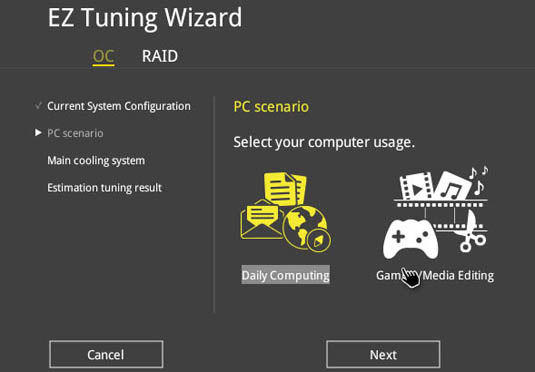
Asus EZ Tuning Wizard: BIOS tweaks made simple for the terminally nervous
Run this and it checks the current system configuration and asks what the system is being used for (daily computing or gaming/media editing). It then asks what type of cooling is being used before giving an estimated tuning result.
What you get is a result that’s somewhat on the conservative side of what you can achieve manually. That said, at least you can get an overclocked system without going deep into the BIOS to tweak settings by using the EZ System Tuning utility.
The Z-97A features the Asus Dual Intelligent Processors 5 technology, which adds a new Turbo App to the four features that came with the Z-87; TPU, EPU, Fan Xpert (which has been updated to version 3) and DIGI+Power. The new Turbo App allows profiles to be set based on applications so the system can be streamlined to perform differently depending on what it’s being asked to run. For instance, with a gaming profile, the CPU can be set to be overclocked, and both the network traffic prioritised and the audio configured to suit gaming.
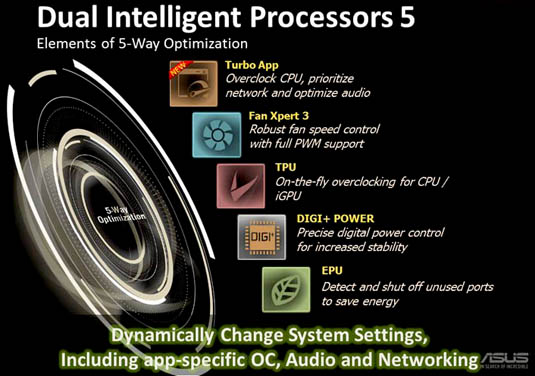
Five easily accessible tech tweaks to make the most of your system
Benchmarking is always going to be tricky given how component variables impact on results – HDD versus SSD being a case in point that affects performance, let alone the processor you choose. Still, as a finger in the wind, I ran some tests using a standard quad-core 3.5GHz Intel i7-4770K CPU, 4GB of DDR-3 2133MHz RAM, a Zotac GTX760 AMP GPU and a Crucial M550 512GB SSD.
PCMark 8 clocked up 4191 for its Home score and the accelerated Home score utilising OpenCL was 4826. Cinebench R15 results were 801 (CPU) and 147fps (OpenGL). Needless to say, there's no shortage of interfacing options including six USB 3.0 and up to 8 USB 2.0 ports, along with DVI-D, DisplayPort, HDMI and VGA. Asus provides a full technical breakdown of the five PCI-E and two PCI slots and its various SATA ports here.
The Reg Verdict
Asus certainly hasn’t held back in offering the best bang for the buck it could muster with the Z97-A, especially when you consider it’s under a tenner cheaper than the previous Z-87-A and has a superior hardware and software set.
If you are in the market for a Haswell based motherboard with a fair degree of future proofing built in, then the Asus Z-97A should be stuck firmly near the top of your list. The revamped BIOS is outstanding and quite something to see and use. Quite frankly, its combination of features and price tag make it a bit of a no-brainer. ®
